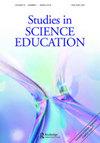科学教育中的承诺和承诺
IF 9.9
2区 教育学
Q1 EDUCATION & EDUCATIONAL RESEARCH
引用次数: 149
摘要
制作是一种迅速兴起的教育实践形式,它涉及设计、建造、测试和修改各种各样的物体,使用高技术和低技术,并整合包括艺术、科学、工程和数学在内的一系列学科。它在政策和教育界获得了广泛的兴趣和支持,因为它已被证明将科学学习与创造力和调查联系起来。制作已在校外环境中扎根,如博物馆、科学节、课后活动和图书馆活动;现在,中小学教育工作者对如何将其纳入课堂越来越感兴趣。Making扩展了与技术教育和基于设计的学习相关的传统,但在可能扩大科学和STEM学习参与的方式上有所不同,包括来自历史上在STEM领域代表性不足的社区的学习者。STEM-Rich Making围绕设计和工程实践集中组织,通常集成数字工具和计算实践,并将科学和数学概念和现象定位为设计的材料。本文对“Making是一种富有成效的科学教学形式”的说法进行了批判,并回顾了当前研究文献对Making支持学生能动性、促进学生积极参与科学和工程实践以及利用学习者文化资源的方式的证实。本文章由计算机程序翻译,如有差异,请以英文原文为准。
The promise and the promises of Making in science education
Abstract Making is a rapidly emerging form of educational practice that involves the design, construction, testing, and revision of a wide variety of objects, using high and low technologies, and integrating a range of disciplines including art, science, engineering, and mathematics. It has garnered widespread interest and support in both policy and education circles because of the ways it has been shown to link science learning to creativity and investigation. Making has taken root in out-of-school settings, such as museums, science festivals, and afterschool and library programmes; and there is now growing interest from primary and secondary educators in how it might be incorporated into the classroom. Making expands on traditions associated with Technology Education and Design-Based Learning, but differs in ways that can potentially broaden participation in science and STEM learning to include learners from communities historically underrepresented in STEM fields. STEM-Rich Making is centrally organised around design and engineering practices, typically integrating digital tools and computational practices, and positions scientific and mathematical concepts and phenomena as the materials for design. This paper takes a critical view of the claims about Making as a productive form of science teaching and learning, and reviews the current research literature’s substantiation of the ways in which Making supports students’ agency, promotes active participation in science and engineering practices, and leverages learners’ cultural resources.
求助全文
通过发布文献求助,成功后即可免费获取论文全文。
去求助
来源期刊

Studies in Science Education
EDUCATION, SCIENTIFIC DISCIPLINES-
CiteScore
15.30
自引率
2.00%
发文量
7
审稿时长
>12 weeks
期刊介绍:
The central aim of Studies in Science Education is to publish review articles of the highest quality which provide analytical syntheses of research into key topics and issues in science education. In addressing this aim, the Editor and Editorial Advisory Board, are guided by a commitment to:
maintaining and developing the highest standards of scholarship associated with the journal;
publishing articles from as wide a range of authors as possible, in relation both to professional background and country of origin;
publishing articles which serve both to consolidate and reflect upon existing fields of study and to promote new areas for research activity.
Studies in Science Education will be of interest to all those involved in science education including: science education researchers, doctoral and masters students; science teachers at elementary, high school and university levels; science education policy makers; science education curriculum developers and text book writers.
Articles featured in Studies in Science Education have been made available either following invitation from the Editor or through potential contributors offering pieces. Given the substantial nature of the review articles, the Editor is willing to give informal feedback on the suitability of proposals though all contributions, whether invited or not, are subject to full peer review. A limited number of books of special interest and concern to those involved in science education are normally reviewed in each volume.
 求助内容:
求助内容: 应助结果提醒方式:
应助结果提醒方式:


